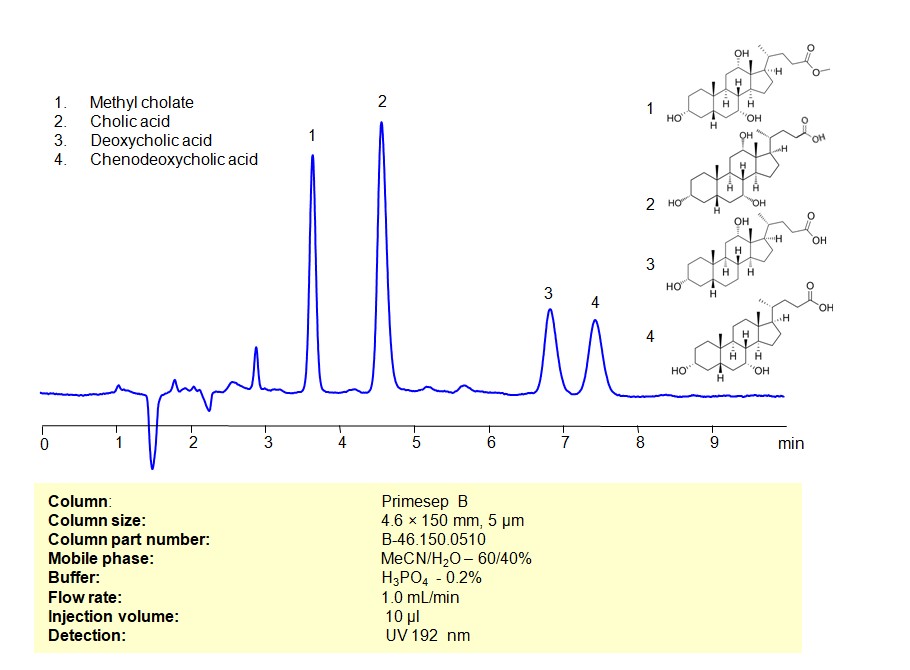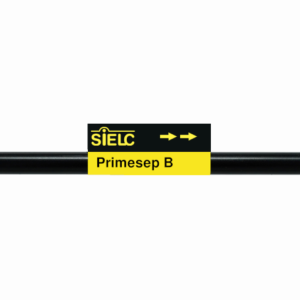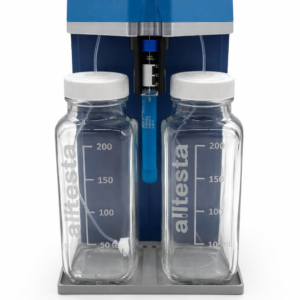HPLC Method for Analysis of Methyl cholate, Cholic acid, Deoxycholic acid, Chenodeoxycholic acid on Primesep B by SIELC Technologies

High Performance Liquid Chromatography (HPLC) Method for Analysis of Methyl cholate, Cholic acid, Deoxycholic acid, Chenodeoxycholic acid
Bile acids are a class of amphipathic molecules derived from cholesterol that play a crucial role in the digestion and absorption of dietary fats. They are synthesized in the liver and released into the small intestine during digestion.
- Cholic Acid:
- Cholic acid is a primary bile acid.
- It is synthesized in the liver from cholesterol.
- Cholic acid contributes to the emulsification and digestion of fats in the small intestine.
- Deoxycholic Acid:
- Deoxycholic acid is a secondary bile acid.
- It is formed by bacterial action in the colon on cholic acid.
- Deoxycholic acid also aids in the digestion and absorption of fats.
- Chenodeoxycholic Acid:
- Chenodeoxycholic acid is another primary bile acid.
- It is synthesized in the liver.
- Like cholic acid, it participates in the emulsification of fats.
- Methyl Cholate:
- Methyl cholate is a derivative of cholic acid.
- It is formed by adding a methyl group to cholic acid.
- Bile acids, including methyl cholate, contribute to the solubilization of lipids.
These bile acids are part of the bile acid pool, which undergoes enterohepatic circulation—being released into the small intestine, reabsorbed in the terminal ileum, and returned to the liver. Bile acids also play a role in cholesterol metabolism and act as signaling molecules.
Their chemical structures, amphipathic nature, and interactions with lipids are essential for their physiological functions in the digestive process. The balance of bile acids in the body is crucial for proper digestion and absorption of dietary fats.
Bile acids can be retained, separated, and analyzed using a Primesep B mixed-mode stationary phase column. The analysis utilizes an isocratic method with a simple mobile phase consisting of water, acetonitrile (MeCN), and sulfuric acid as a buffer. Detection is achieved using UV at 192 nm
| Column | Primesep B, 4.6 x 150 mm, 5 µm, 100 A, dual ended |
| Mobile Phase | MeCN/H2O – 60/40% |
| Buffer | H3PO4 -0.2% |
| Flow Rate | 1.0 ml/min |
| Detection | UV 192 nm |
| Samples | 2 mg/mL in MeCN/H2O – 50/50% |
| Injection volume | 10 µl |
| LOD* | 0.2 ppm |
| Class of Compounds | bile acids |
| Analyzing Compounds | Methyl cholate, Cholic acid, Deoxycholic acid, Chenodeoxycholic acid |
Application Column
Primesep B
Column Diameter: 4.6 mm
Column Length: 150 mm
Particle Size: 5 µm
Pore Size: 100 A
Column options: dual ended
Cholic acid
Deoxycholic acid
Methyl cholate





